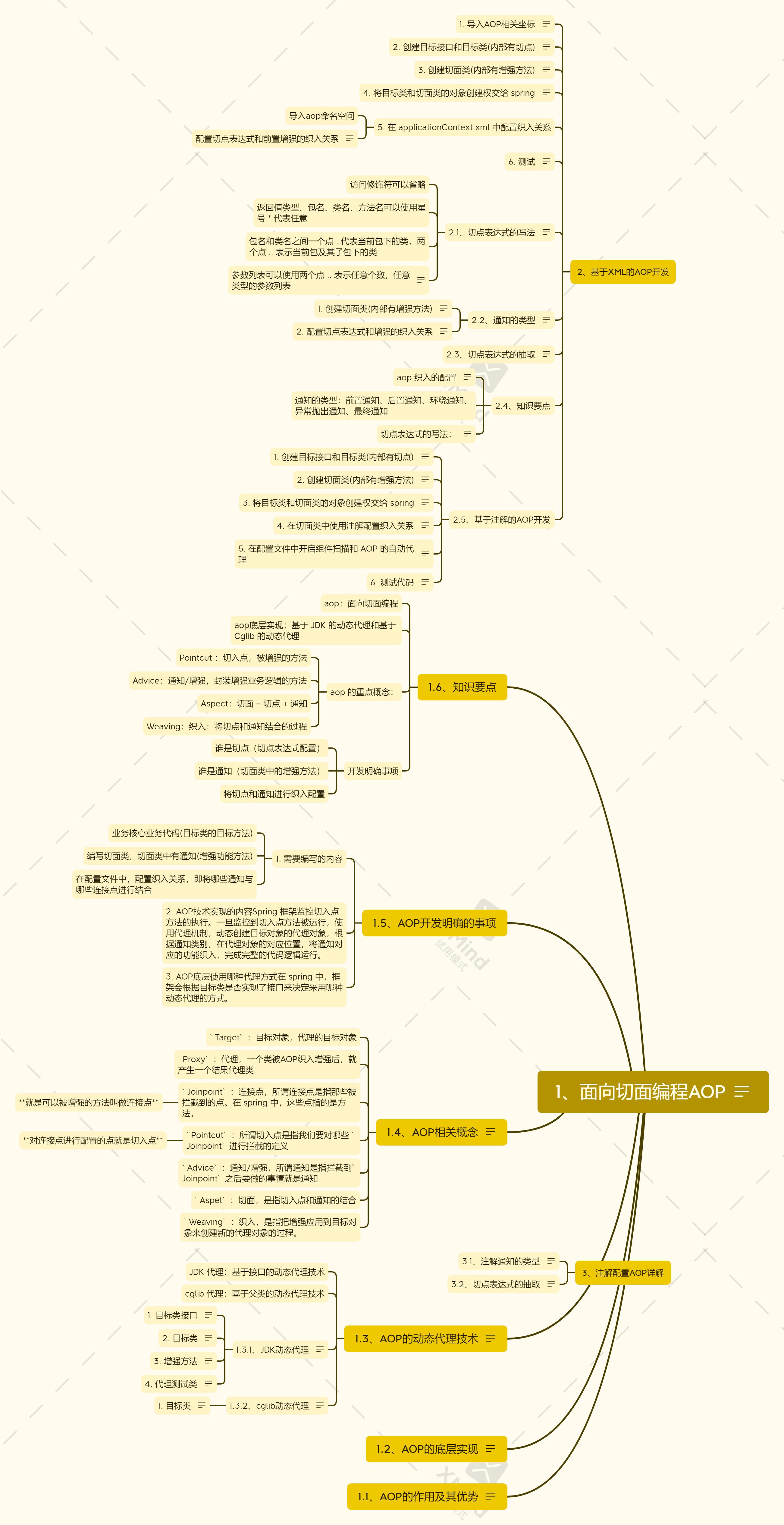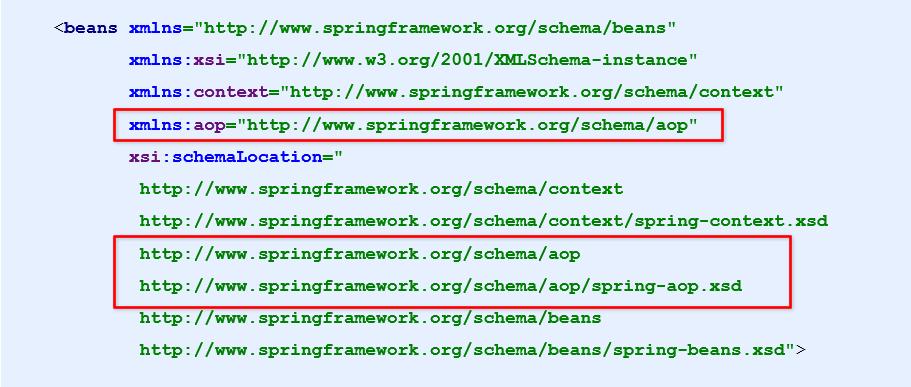Spring框架技术总结
Posted 生命是有光的
tags:
篇首语:本文由小常识网(cha138.com)小编为大家整理,主要介绍了Spring框架技术总结相关的知识,希望对你有一定的参考价值。
0、目录总览

1、面向切面编程AOP
什么是AOP?
- AOP:Aspect Oriented Programming 的缩写,意思为面向切面编程,是通过预编译方式和运行期动态代理实现程序功能的统一维护的一种技术。
- AOP 是 OOP 的延续,是软件开发中的一个热点,也是Spring框架中的一个重要内容,是函数式编程的一种衍生范型。
- 利用AOP可以对业务逻辑的各个部分进行隔离,从而使得业务逻辑各部分之间的耦合度降低,提高程序的可重用性,同时提高了开发的效率。
1.1、AOP的作用及其优势
作用:在程序运行期间,在不修改源码的情况下对方法进行功能增强
优势:减少重复代码,提高开发效率,并且便于维护
1.2、AOP的底层实现
实际上,AOP 的底层是通过 Spring 提供的动态代理技术实现的。在运行期间,Spring 通过动态代理技术动态的生成代理对象,代理对象方法执行时进行增强功能的介入,再去调用目标对象的方法,从而完成功能的增强。
1.3、AOP的动态代理技术
常用的动态代理技术:
- JDK 代理:基于接口的动态代理技术
- cglib 代理:基于父类的动态代理技术
1.4、AOP相关概念
Spring的AOP实现底层就是对上面的动态代理的代码进行了封装,封装后我们只需要对需要关注的部分进行代码编写,并通过配置的方式完成指定目标的方法增强。
常用AOP的术语如下:
-
Target:目标对象,代理的目标对象 -
Proxy:代理,一个类被AOP织入增强后,就产生一个结果代理类 -
Joinpoint:连接点,所谓连接点是指那些被拦截到的点。在 spring 中,这些点指的是方法,- 就是可以被增强的方法叫做连接点
-
Pointcut:所谓切入点是指我们要对哪些Joinpoint进行拦截的定义- 对连接点进行配置的点就是切入点
-
Advice:通知/增强,所谓通知是指拦截到Joinpoint之后要做的事情就是通知 -
Aspet:切面,是指切入点和通知的结合 -
Weaving:织入,是指把增强应用到目标对象来创建新的代理对象的过程。
1.5、AOP开发明确的事项
-
需要编写的内容
- 业务核心业务代码(目标类的目标方法)
- 编写切面类,切面类中有通知(增强功能方法)
- 在配置文件中,配置织入关系,即将哪些通知与哪些连接点进行结合
-
AOP技术实现的内容
Spring 框架监控切入点方法的执行。一旦监控到切入点方法被运行,使用代理机制,动态创建目标对象的代理对象,根据通知类别,在代理对象的对应位置,将通知对应的功能织入,完成完整的代码逻辑运行。
-
AOP底层使用哪种代理方式
在 spring 中,框架会根据目标类是否实现了接口来决定采用哪种动态代理的方式。
1.6、知识要点
-
aop:面向切面编程
-
aop底层实现:基于 JDK 的动态代理和基于 Cglib 的动态代理
-
aop 的重点概念:
- Pointcut :切入点,被增强的方法
- Advice:通知/增强,封装增强业务逻辑的方法
- Aspect:切面 = 切点 + 通知
- Weaving:织入:将切点和通知结合的过程
-
开发明确事项
- 谁是切点(切点表达式配置)
- 谁是通知(切面类中的增强方法)
- 将切点和通知进行织入配置
2、基于XML的AOP开发
- 导入AOP相关坐标
<dependency>
<groupId>org.springframework</groupId>
<artifactId>spring-context</artifactId>
<version>5.0.5.RELEASE</version>
</dependency>
<dependency>
<groupId>org.aspectj</groupId>
<artifactId>aspectjweaver</artifactId>
<version>1.8.4</version>
</dependency>
<dependency>
<groupId>org.springframework</groupId>
<artifactId>spring-test</artifactId>
<version>5.0.2.RELEASE</version>
</dependency>
<dependency>
<groupId>junit</groupId>
<artifactId>junit</artifactId>
<version>4.12</version>
</dependency>
- 创建目标接口和目标类(内部有切点)
public interface TargetInterface{
public void method();
}
public class Target implements TargetInterface {
@Override
public void method(){
System.out.println("save running...");
}
}
- 创建切面类(内部有增强方法)
public class MyAspect {
// 前置增强方法
public void before(){
System.out.println("前置增强");
}
}
- 将目标类和切面类的对象创建权交给 spring
<!--配置目标类-->
<bean id="target" class="com.itheima.aop.Target"></bean>
<!--配置切面类-->
<bean id="myAspect" class="com.itheima.aop.MyAspect"></bean>
- 在 applicationContext.xml 中配置织入关系
- 导入aop命名空间
- 配置切点表达式和前置增强的织入关系

<!-- 配置织入:告诉spring框架,哪些方法(切点)需要进行哪些增强(前置增强、后置增强、...)-->
<aop:config>
<!--引用myAspect的Bean为切面对象-->
<aop:aspect ref="myAspect">
<!--配置Target的method方法执行时要进行myAspect的before方法前置增强-->
<aop:before
method="before"
pointcut="execution(public void com.itheima.aop.Target.method())"> </aop:before>
</aop:aspect>
</aop:config>
- 测试
@RunWith(SpringJUnit4ClassRunner.class)
@ContextConfiguration("classpath:applicationContext.xml")
public class AopTest {
@Autowired
private TargetInterface target;
@Test
public void test1(){
target.save();
}
}

2.1、AOP配置
2.1.1、aop:config
-
名称:
aop:config -
类型:标签
-
归属:beans标签
-
作用:设置AOP:设置当前类为切面类
-
格式:
<beans> <aop:config>……</aop:config> <aop:config>……</aop:config> </beans> -
说明:一个beans标签中可以配置多个aop:config标签
2.1.2、aop:aspect
-
名称:
aop:aspect -
类型:标签
-
归属:aop:config标签
-
作用:设置具体的AOP通知对应的切入点
-
格式:
<aop:config> <aop:aspect ref="beanId">……</aop:aspect> <aop:aspect ref="beanId">……</aop:aspect> </aop:config> -
说明:
一个aop:config标签中可以配置多个aop:aspect标签
-
基本属性:
- ref :通知所在的bean的id
2.1.3、aop:pointcut
-
名称:
aop:pointcut -
类型:标签
-
归属:aop:config标签、aop:aspect标签
-
作用:设置切入点
-
格式:
<aop:config> <aop:pointcut id="pointcutId" expression="……"/> <aop:aspect> <aop:pointcut id="pointcutId" expression="……"/> </aop:aspect> </aop:config> -
说明:
一个aop:config标签中可以配置多个aop:pointcut标签,且该标签可以配置在aop:aspect标签内
-
基本属性:
-
id:识别切入点的名称 -
expression:切入点表达式
-
2.1、切点表达式
切入点:
-
切入点描述的是某个方法
-
切入点表达式是一个快速匹配方法描述的通配格式,类似于正则表达式
表达式语法:
execution([修饰符] 返回值类型 包名.类名.方法名(参数))
execution(public void com.itheima.aop.Target.save())
-
访问修饰符可以省略
-
返回值类型、包名、类名、方法名可以使用星号 * 代表任意
-
包名和类名之间一个点 . 代表当前包下的类,两个点 … 表示当前包及其子包下的类
-
参数列表可以使用两个点 … 表示任意个数,任意类型的参数列表
-
*:单个独立的任意符号,可以独立出现,也可以作为前缀或者后缀的匹配符出现execution(public * com.itheima.*.UserService.find*(*)) -
匹配com.itheima包下的任意包中的UserService类或接口中所有find开头的带有一个参数的方法
-
..:多个连续的任意符号,可以独立出现,常用于简化包名与参数的书写execution(public User com..UserService.findById(..)) -
匹配com包下的任意包中的UserService类或接口中所有名称为findById的方法
例如:
execution(public void com.itheima.aop.Target.method())
execution(void com.itheima.aop.Target.*(..))
execution(* com.itheima.aop.*.*(..))
execution(* com.itheima.aop..*.*(..))
execution(* *..*.*(..))
2.2、通知的类型
通知的配置语法:
<aop:通知类型 method="切面类中方法名" pointcut="切点表达式"></aop:通知类型>
| 名称 | 标签 | 说明 |
|---|---|---|
| 前置通知 | <aop:before> | 用于配置前置通知。指定增强的方法在切入点方法之前执行 |
| 后置通知 | <aop:after-returning> | 用于配置后置通知。指定增强的方法在切入点方法之后执行 |
| 环绕通知 | <aop:around> | 用于配置环绕通知。指定增强的方法在切入点方法之前和之后都执行 |
| 异常抛出通知 | <aop:throwing> | 用于配置异常抛出通知。指定增强的方法在出现异常时执行 |
| 最终通知 | <aop:after> | 用于配置最终通知。无论增强方式执行是否有异常都会执行 |
2.2.1、aop:before
-
名称:
aop:before -
类型:标签
-
归属:aop:aspect标签
-
作用:设置前置通知
-
格式:
<aop:aspect ref="adviceId"> <aop:before method="methodName" pointcut="……"/> </aop:aspect> -
说明:一个aop:aspect标签中可以配置多个aop:before标签
-
基本属性:
method:在通知类中设置当前通知类别对应的方法pointcut:设置当前通知对应的切入点表达式,与pointcut-ref属性冲突pointcut-ref:设置当前通知对应的切入点id,与pointcut属性冲突
2.2.2、aop:after-returning
-
名称:
aop:after-returning -
类型:标签
-
归属:aop:aspect标签
-
作用:设置返回后通知
-
格式:
<aop:aspect ref="adviceId"> <aop:after-returning method="methodName" pointcut="……"/> </aop:aspect> -
说明:一个aop:aspect标签中可以配置多个aop:after-returning标签
-
基本属性:
-
method:在通知类中设置当前通知类别对应的方法 -
pointcut:设置当前通知对应的切入点表达式,与pointcut-ref属性冲突 -
pointcut-ref:设置当前通知对应的切入点id,与pointcut属性冲突
-
2.2.2、aop:around
-
名称:
aop:around -
类型:标签
-
归属:aop:aspect标签
-
作用:设置环绕通知
-
格式:
<aop:aspect ref="adviceId"> <aop:around method="methodName" pointcut="……"/> </aop:aspect> -
说明:一个aop:aspect标签中可以配置多个aop:around标签
-
基本属性:
-
method:在通知类中设置当前通知类别对应的方法 -
pointcut:设置当前通知对应的切入点表达式,与pointcut-ref属性冲突 -
pointcut-ref:设置当前通知对应的切入点id,与pointcut属性冲突
-
2.2.3、aop:after-throwing
-
名称:
aop:after-throwing -
类型:标签
-
归属:aop:aspect标签
-
作用:设置抛出异常后通知
-
格式:
<aop:aspect ref="adviceId"> <aop:after-throwing method="methodName" pointcut="……"/> </aop:aspect> -
说明:一个aop:aspect标签中可以配置多个aop:after-throwing标签
-
基本属性:
-
method:在通知类中设置当前通知类别对应的方法 -
pointcut:设置当前通知对应的切入点表达式,与pointcut-ref属性冲突 -
pointcut-ref:设置当前通知对应的切入点id,与pointcut属性冲突
-
2.2.4、示例
- 创建切面类(内部有增强方法)
public class MyAspect {
//前置增强
public void before(){
System.out.println("前置增强....");
}
//后置增强
public void afterReturning(){
System.out.println("后置增强....");
}
//环绕增强
//Proceeding JoinPoint:正在执行的连接点 == 切点
public Object around(ProceedingJoinPoint pjp){
System.out.println("环绕前增强....");
Object proceed = pjp.proceed();
System.out.println("环绕后增强....");
return proceed;
}
//异常抛出增强
public void afterThrowing(){
System.out.println("异常抛出增强....");
}
//最终通知增强
public void after(){
System.out.println("最终通知增强....");
}
}
- 配置切点表达式和增强的织入关系
<!--配置织入-->
<aop:config>
<!--引用myAspect的Bean为切面对象-->
<aop:aspect ref="myAspect">
<!--前置增强-->
<aop:before method="myPointcut" pointcut="execution(* com.itheima.aop.*.*(..))"/>
<!--环绕增强-->
<aop:around method="around" pointcut="execution(* com.itheima.aop.*.*(..))" />
<!--前置增强-->
<aop:after-returning method="afterRetruning" pointcut="(* com itheima.aop.*.*(..))" />
<!--异常增强-->
<aop:after-returning method="afterThrowing" pointcut="(* com itheima.aop.*.*(..))" />
<!--最终通知增强-->
<aop:after method="after" pointcut="(* com itheima.aop.*.*(..))" />
</aop:aspect>
</aop:config>
2.3、切点表达式的抽取
当多个增强的切点表达式相同时,可以将切点表达式进行抽取,在增强中使用 pointcut-ref 属性代替 pointcut 属性来引用抽取后的切点表达式
<!--配置织入-->
<aop:config>
<!--引用myAspect的Bean为切面对象-->
<aop:aspect ref="myAspect">
<!--抽取切点表达式-->
<aop:pointcut id="myPointcut" expression="execution(* com.itheima.aop.*.*(..))"></aop:pointcut>
<!--前置增强-->
<aop:before method="myPointcut" pointcut-ref="myPointcut"/>
<!--环绕增强-->
<aop:around method="around" pointcut-ref="myPointcut" />
<!--前置增强-->
<aop:after-returning method="afterRetruning" pointcut-ref="myPointcut" />
<!--异常增强-->
<aop:after-returning method="afterThrowing" pointcut-ref="myPointcut" />
<!--最终通知增强-->
<aop:after method="after" pointcut-ref="myPointcut" />
</aop:aspect>
</aop:config>
2.4、知识要点
- aop 织入的配置
<aop:config>
<aop:aspect ref="切面类">
<aop:before method="通知方法名称" pointcut="切点表达式"></aop:before>
</aop:aspect>
</aop:config>
- 通知的类型:前置通知、后置通知、环绕通知、异常抛出通知、最终通知
- 切点表达式的写法:
execution([修饰符] 返回值类型 包名.类名.方法名(参数))
2.5、基于注解的AOP开发
- 创建目标接口和目标类(内部有切点)
public interface TargetInterface {
public void method();
}
public class Target implements TargetInterface {
@Override
public void method(){
System.out.println("Target running...");
}
}
- 创建切面类(内部有增强方法)
public class MyAspect {
//前置增强方法
public void before() {
System.out.println("前置代码增强...");
}
}
- 将目标类和切面类的对象创建权交给 spring
@Component("target")
public class Target implements TargetInterface {
@Override
public void method() {
System.out.println("Target running....");
}
}
@Component("myAspect")
public class MyAspect {
public void before() {
System.out.